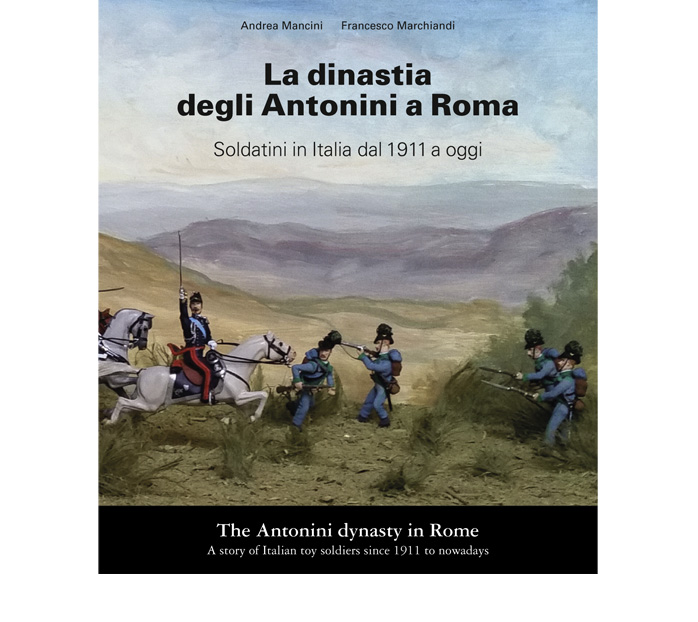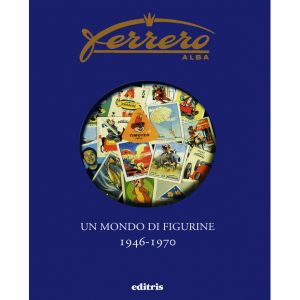La dinastia degli Antonini a Roma
38,00€
Soldatini in Italia dal 1911 a oggi
The Antonini Dynasty in Rome
A story of the Italian toy soldiers since 1911 to nowadays
Collezionismo
autori: Andrea Mancini, Francesco Marchiandi
208 pagine a colori
più di 280 fotografie
formato 22,5×26 cm, dorso 20 mm
copertina cartonata rigida
italiano, english
Repertorio fotografico generale
Rassegna stampa
© 2019 editris duemila snc, Torino
ISBN-9788889853542
Descrizione
Una grande rassegna dei soldatini prodotti in Italia da La Dinastia degli Antonini a Roma e dai loro principali concorrenti nazionali.
Il nonno Francesco iniziò nel 1911 a Roma la produzione di soldatini di piombo con il marchio L.G.P e nel 1927 creò una nuova ditta F.I.G.I.R. per produrre soldatini di pasta.
Il figlio Luciano, a partire dai primi anni Sessanta, creò tante nuove serie di soldatini per i collezionisti. Alcune di esse sono dedicate a soggetti unici al mondo, ad esempio quelle dei soldatini degli Stati preunitari italiani. Nel 1984 aprì a Roma “La Bottega del Soldatino”.
Qui il nipote Lorenzo continua ancora oggi a produrre su ordinazione alcune delle serie più belle usando i vecchi stampi della famiglia.
La Dinastia degli Antonini a Roma, con testo in italiano e in inglese, corredato da molte fotografie per illustrare bene i dettagli dei modelli e consentire al collezionista di identificare le figure. Anche le didascalie sono in italiano e in inglese.
Il volume è composto da:
– più di 200 pagine stampate interamente a colori;
– oltre 250 soggetti finemente riprodotti;
– 5 capitoli che documentano la produzione italiana
di soldatini di pasta e di piombo;
– un’appendice finale riccamente illustrata.
Additional Information
| Description | A comprehensive review of toy soldiers produced in Italy by three generations of Antonini and by their most important national competitors. |
|---|





redazione –
Univ.-Prof. Dr. Ignacio Czeguhn
Professore presso la Facoltà di legge di Berlino: Diritto civile, storia giuridica tedesca ed europea e comparata
Collezionista
8/1/2020:
I find your book very good. It is a very intensive information about the history of the Antonini family and his creativity. The photos are very good and the text is informative. It is a good replenishment for the history of the European toy soldiers and figures.
redazione –
Alfred Umhey
Studioso e scrittore di Storia Militare e uniformologia.
Collezionista
aprile 2020-05-24
The Antonini Dynasty in Rome
A story of Italian toy soldiers since 1811 to nowadays
When I first heard about the new book of Andrea Mancini and Francesco Marchiandi
I decided immediately to add it to my library. Knowing both the authors as well as Luciano and Francesco Antonini and their shop in Rome, I expected a work of interesting information and beautiful images. In both aspects my expectations were surpassed.
Already the main story of the Antonini Family and their various production lines provided very useful information about the background of many models on my shelves. The survey of other Italian figure producers brought back some nice memories of the beginning of my collectors activities in the late 70’s and early 80’s, when the rich Italian military history manifested in colourful figures with a great variety of subjects. While this was a nice and useful addition, the main force of the book is the lavishly illustrated story of Antonini’s work. A vast panorama of high quality images reflects the different stages of the family activities. The selection of the pictures provide a good survey of the production and the various approaches in glossy and matt painting. Also the collaborations with Pranzetti and Del Vecchio are well explained.
So again I found the story behind many figures I had in my collection for a long time.
Among the numerous books about Toy soldiers, this book has it’s special place. It’s an aesthetic work and a solid compilation of facts. On can only congratulate the authors for this publication.
Highly recommended!
La dynastie Antonini à Rome
Une histoire de petits soldats italiens de 1811 à nos jours
Quand j’ai entendu parler pour la première fois du nouveau livre d’Andrea Mancini et Francesco Marchiandi, j’ai décidé immédiatement de l’ajouter à ma bibliothèque. Connaissant à la fois les auteurs ainsi que Luciano et Francesco Antonini et leur boutique à Rome, je m’attendais à un travail d’informations intéressantes et de belles images. Dans les deux aspects, mes attentes ont été dépassées.
Déjà l’histoire principale de la famille Antonini et de ses différentes lignes de production a fourni des informations très utiles sur l’arrière-plan de nombreux modèles sur mes étagères. L’enquête auprès d’autres producteurs de figures italiennes m’a rappelé de bons souvenirs du début de mes activités de collectionneur à la fin des années 70 et au début des années 80, lorsque la riche histoire militaire italienne s’est manifestée par des figures colorées avec une grande variété de sujets. Bien que ce fut un ajout agréable et utile, la principale force du livre est l’histoire somptueusement illustrée du travail de Antonini pére et fils. Un vaste panorama d’images de haute qualité reflète les différentes étapes des activités familiales. La sélection des images offre un bon aperçu de la production et des différentes approches de la peinture brillante et mate. Les collaborations avec Pranzetti et Del Vecchio sont également bien expliquées.
Encore une fois, j’ai trouvé l’histoire derrière de nombreuses figures que j’avais dans ma collection depuis longtemps.
Parmi les nombreux livres sur les soldats Toy, ce livre a sa place spéciale. C’est un travail esthétique et une solide compilation de faits. On ne peut que féliciter les auteurs pour cette publication.
Hautement recommandé!
redazione –
ottimo
redazione –
Rivista SOLDATINI n. 146 gennaio-febbraio 2021
Paolo Di Marco
LA DINASTIA DEGLI ANTONINI, la storia della più antica fabbrica italiana di soldatini.
Un bel volume viene opportunamente a celebrare una storica produzione nazionale di soldatìnì, ben nota agli appassionati non solo italiani, la ditta Antonìnì di Roma, colmando così una lacuna nel campo della specifica bibliografia.
Il libro, in carta lucida e formato elegante, copertina rigida a colori, cm. 23 x 26,5, è opera dì Andrea Mancini (di Roma) e Francesco Marchiandi (di Torino), segno che questa passione unisce davvero al dì là delle distanze. Sono 206 pagine con testo italiano e inglese, arricchite da 280 pregevoli illustrazioni di figurini antichi e moderni, puntuali e precise didascalie e la possibilità, scansionando un QRCode, dì accedere ad un ricco repertorio fotografico della produzione Antonini ed a campionari e cataloghi dei diversi periodi.
In ciascun capitolo gli autori accennano anche a quella che, tempo per tempo, fu la concorrenza nazionale, ricordando i maggiori competìtor. Il prezzo dì listino, 38,00 euro, appare adeguato alle caratteristiche e tipologìa dell’opera.
“La Bottega del Soldatino” della famiglia Antonìnì è, nel suo genere, la più antica d’Italia e figura in Europa fra quelle che più a lungo e ininterrottamente hanno prodotto soldatini e modelli militari.
I primi passi nel campo sì devono a Francesco Antonini che nel 1911 importò dalla “Gebruder Schneider” di Lipsia alcuni stampi in alluminio, ancor oggi conservati nel laboratorio della ditta. Una sciccherìa d’avanguardia per l’epoca, che permettevano di riprodurre soggetti “semi tondi” in piombo: fanti prussiani, coloniali inglesi, ussari, lancìerì, indiani a caccia dì bisonti, cow boys, beduini, animali della fattoria, piccoli velieri e anche un presepe con angeli e cometa.
Nel1912 Francesco Antoninì allarga l’attività realizzando ì suoi propri stampi e i primi soggetti autonomi che distribuisce con il marchio “L.G.P.” (Laboratorio di Giocattoli in Piombo). Il marchio figura sulle etichette delle scatole ma non è impresso sui soldatini, contraddistinti dalla basetta rotonda (o ovale) che ancora oggi lì caratterizza. I nuovi stampi, in bronzo, consentono di realizzare modelli a tutto tondo anziché semi-tondi come ì precedenti. Le prime serie sono dedicate all’esercito ottomano contro cui erano allora impegnate le nostre truppe nella Guerra ltalo-Turca: il successo è immediato. Seguono molte altre sculture che riproducono le uniformi dell’esercito nazionale allargando sempre più il ventaglio delle proposte. Il laboratorio si specializza nella produzione di soldatinì del Regno d’Italia e, in seguito, Borbonici, ma non dimentica altri paesi e periodi. Infatti, in quelle ormai definite come “serie storiche”, troviamo Britannici, Napoleonici, Zuavi, i colorati eserciti del XVIII secolo (in parte ispirati a soggetti di marche francesi e tedesche) e, più insolita, una serie dì maschere italiane della Commedia dell’Arte. l figurini hanno un aspetto ingenuo e simpaticamente tondeggiante; dipinti con smalto lucido sono, a tutti gli effetti, dei giocattoli, anche se anni dopo saranno richiesti da collezionisti e appassionati.
Per seguire il mercato che si orienta verso soldatini meno costosi e “infrangibili”, come allora si diceva, nel 1927 Antonini brevetta una speciale pasta di legno, dura e resistente, con la quale avvia una nuova produzione. Questi soggetti, un po’ più grandi dì quelli in piombo (circa 60 mm.), sono stampati a freddo con stampi in bronzo e grossi torchi a mano. Si comincia con le tenute grigioverdi dell’esercito italiano; seguono i nostri coloniali, Ascari, Dubat, Abissini, le uniformi vivaci dei Carabinieri a piedi e a cavallo con le relative bande e ancora Corazzieri, Guardie Pontificie, soldati svizzeri, Giubbe Rosse canadesi, Indiani, cow boys e la serie di animali dello zoo. Sono venduti con il marchio F.I.G.I.R. (Fabbrica Italiana Giocattoli Infrangibili Roma) che viene impresso sotto le basette, anche queste tondeggianti.
Nel 1950, per soddisfare le crescenti e vivaci richieste dei collezionisti, Antonini riprende la produzione delle più antiche serie in metallo utilizzando ancora i vecchi stampi. I nuovi soggetti sono però rifiniti e colorati con maggior cura e attenzione ai particolari. Per la fusione si adotta una lega ad alto contenuto di stagno che rende più duraturi e inalterabili i modelli, non più destinati alla precaria esistenza di un giocattolo. Le serie di maggior successo sono ancora quelle italiane, come l’intero esercito nazionale degli anni 1861-66 e quello umbertino dì fine Ottocento.
Nel 1968 cessa la produzione dei soldatini in pasta di legno, sostituiti sul mercato dai più pratici giocattoli in plastica, e la Antonìnì orienta definitivamente la sua produzione sui modelli da collezione in metallo.
Luciano Antoninì, che fin da ragazzo aveva affiancato il padre nell’attività, realizza le nuove serie nella misura standard di 54 mm. Si adottano moderne macchine per la fusione con stampi in gomma vulcanìzzata. Le nuove serie storiche sono dedicate agli Stati preunìtari, al Risorgimento e sì riprende il ‘700 con il Regno di Napoli e quello dì Sardegna. Gli stilizzati cavallini al trotto dei vecchi soggetti cedono il passo a cavalli più vivaci e realistici in varie pose dinamiche, grazie anche alla collaborazione con Augusto Pranzetti. Si abbandonano anche le tradizionali basette tondeggianti per adottare
quelle rettangolari.
A Pranzettì sì devono pure alcuni soggetti dì particolare valore artistico come “La carica dei Carabinieri a Pastrengo” e l’epopea Garibaldina. Con lui si avviano pure alcune serie (Prima Guerra Mondiale e Coloniali) vendute anche in buste di montaggio da assemblare e dipingere per quanti vogliono realizzare personalmente ì kìt.
Verso la fine degli anni ’70, in collaborazione con Giovanni Del Vecchio, la ditta avvia un ambizioso progetto: rappresentare con figurini l’intero esercito Murattiano. Questi splendidi e coloratissimi soggetti saranno tutti disponibili anche in kit da montare, scomposti in diversi pezzi di particolare realismo e dettaglio.
Attualmente la “La Bottega del Soldatino” è in grado, a richiesta, di fornire qualsiasi soggetto della produzione Antonini e di provvedere all’attento restauro di quelli più antichi o rovinati.
Storia esemplare di lungo e meritato successo di una bottega che ha contato fra i suoi clienti anche noti uomini politici come Francesco Cossiga, Giovanni Spadolini e Antonio Gava!
Vedi allegato
redazione –
Rivista SOLDATINI n. 146 gennaio-febbraio 2021
Paolo Di Marco
LA DINASTIA DEGLI ANTONINI, the history of the oldest Italian toy soldier factory.
A good volume comes to celebrate a historic national production of toy soldiers, well known to fans not only ltalians, the Antonini company in Rome, thus filling a gap in the field of specific bibliography.
The book, in glossy paper and elegant format, hard cover in color, cm. 23 x 26.5, is the work of Andrea Mancini ( of Rome) and Francesco Marchiandi (ofTurin), a sign that this passion really unites over distances. There are 206 pages with ltalian and English text, enriched by 280 valuable illustrations of antique and modem sketches, punctual and precise captions and the possibility, by scanning a QRCode, to access a rich photographic repertoire of Antonini’s production and to samples and catalogs of the different periods. In each chapter the authors also mention what, from time to time, was the national competition, recalling the major competitors. The list price, 38,00 euros, appears adequate to the characteristics and type of the work.
“La Bottega del Soldatino” of the Antonini family is, of its kind, the oldest in ltaly and is one of those that have produced toy soldiers and military models in Europe far a long time and continuously.
The first steps in the field are due to Francesco Antonini who in 1911 imported from the “Gebruder Schneider” of Leipzig
some aluminum molds, still preserved in the laboratory of the company. An avant-garde sciccheria for the time, which made
it possible to reproduce “semi-round” subjects in lead: Prussian infantry, English colonial , hussars, spearmen , lndians hunting bison, cow boys, Bedouins, farm animals, small sailing ships and also a nativity scene with angels and comet.
In 1912 Francesco Antonini expands the business by creating his own molds and the first independent subjects that he distributes under the “L.G .P.” (Lead Toys Laboratory). The brand appears on the labels of the boxes but is not imprinted on the toy soldiers, distinguished by the round (or oval) base that still characterizes them today . The new bronze molds make it possible to create full-round models rather than semi-round ones like the previous ones. The first series are dedicated to the Ottoman army against which our troops were then engaged in the Italo-Turkish War: success was immediate. Many other sculptures follow that reproduce the uniforms of the national army, widening the range of proposals more and more.
The laboratory specializes in the production of toy soldiers from the Kingdom of Italy and, later, the Bourbons, but does
not forget other countries and periods. In fact, in those now defined as “historical series”, we find British, Napoleonic,
Zouaves, the colorful armies of the eighteenth century (partly inspired by subjects of French and German brands) and, more unusual, a series of Italian masks from the Commedia dell’Arte. The figures have a naive and pleasantly rounded appearance; painted with glossy enamel are, in all respects, toys, even if years later they will be requested by collectors and enthusiasts.
To follow the market which is oriented towards less expensive and “unbreakable” toy soldiers, as was then said, in 1927 Antonini patents a special wood pulp, hard and resistant, with which he starts a new production.
These subjects, a little larger than those in lead (about 60 mm.), are cold pressed with bronze molds and large hand presses. It begins with the green-gray suits of the Italian army; followed by our coloniaI, Ascari, Dubat, Abyssinians, the lively uniforms of the Carabinieri on foot and on horseback with their bands and also Cuirassiers, Papal Guards, Swiss soldiers, Canadian Red Jackets, Indians, cow boys and the series of zoo animals. They are sold under the F.l.G.l.R. (ltalian Unbreakable Toys Factory Rome) which is imprinted under the sideburns, which are also rounded.
In 1950, to satisfy the growing and lively requests of collectors, Antonini resumed the production of the oldest metal series, still using the old molds. The new subjects, however, are finished and colored with greater care and attention to detail. For the casting, an alloy with a high tin content is adopted which makes the models more durable and unalterable, no longer destined far the precarious existence of a toy.
The most successful series are still the Italian ones, such as the entire national army of the years 1861-66 and the Umbertino army of the late nineteenth century.
In 1968 the production of wood pulp toy soldiers ceased, replaced on the market by more practical plastic toys, and Antonini definitively oriented its production on collectible metal models.
Luciano Antonini, who hod supported his father in the business since he was a boy, creates the new series in the standard size of 54 mm. Modem machines are adopted far casting with vulca rubber molds.
Vedi allegato